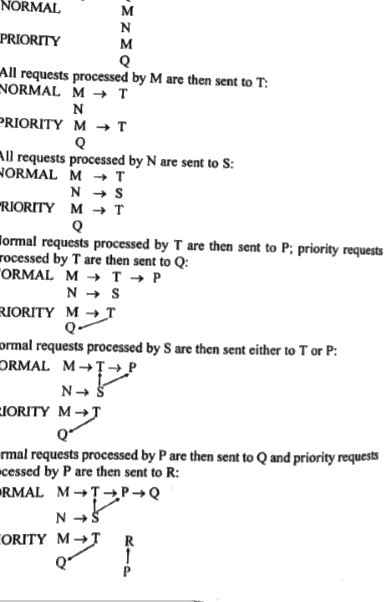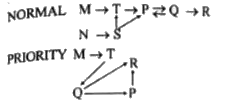An information processing system consists of seven stations - M,N,P,Q,R,S and T. Every request is classified as either normal or priority. Requests for information are processed in the following ways:
(i) All normal requests are received by either M or N, and all priority requests are received by M or Q.
(ii) All requests processed by M are then sent to T.
(iii) All requests processed by N are then sent to S.
(iv) Normal requests processed by T'are then sent to P, priority requests processed by T are then sent to Q.
(v) All requests processed by S are then sent to cither T or P.
(vi) Normal requests processed by P are then sent to Q, and prioriy requests processed by P are then sent to R.
(vii) All requests processed by Q are then sent to either P or R.
(viii) R is the station which issues a final response.
I.
P II. Q
III. M
I only
III only
I and II only
I and III only
The correct Answer is:D
This is a "network" set. Begin by drawing the diagram :
All normal requests are received by either M or N, and all priority requests are received by M or Q :

All requests processed by Q are then sent to either P or R:

Everything R receives must at some point have passed through station Q. so II is not part of the correct answer. There are certain requests. however, that P does not handle, namely those priority requests forwarded by Q directly to R Also, there are certain requests that M does not handle, namely those normal requests that begin with N and those priority requests that begin with Q.
Topper's Solved these Questions
- PROBLEM SOLVINGBOOK - M K PANDEYCHAPTER - PROBLEM SOLVINGEXERCISE - (EXERCISE 20 B)
100 Videos
- INPUT-OUTPUT(..CONTD):ARRANAGEMENTBOOK - M K PANDEYCHAPTER - INPUT-OUTPUT(..CONTD):ARRANAGEMENTEXERCISE - PRACTICE EXERCISE
41 Videos
- SYLLOGISMBOOK - M K PANDEYCHAPTER - SYLLOGISMEXERCISE - PRACTICE EXERCISES (TYPE III: EXERCISE 11 C)
25 Videos
Similar Questions
Site where all the information are processed & controlled is___________.
View SolutionAn information processing system consists of seven stations - M,N,P,Q,R,S and T. Every request is classified as either normal or priority. Requests for information are processed in the following ways:
(i) All normal requests are received by either M or N, and all priority requests are received by M or Q.
(ii) All requests processed by M are then sent to T.
(iii) All requests processed by N are then sent to S.
(iv) Normal requests processed by T'are then sent to P, priority requests processed by T are then sent to Q.
(v) All requests processed by S are then sent to cither T or P.
(vi) Normal requests processed by P are then sent to Q, and prioriy requests processed by P are then sent to R.
(vii) All requests processed by Q are then sent to either P or R.
(viii) R is the station which issues a final response.
If a request is processed more than once by the same station, then that station must be
I. P
II. Q.
III. T
View Solution
Knowledge Check
An information processing system consists of seven stations - M,N,P,Q,R,S and T. Every request is classified as either normal or priority. Requests for information are processed in the following ways:
(i) All normal requests are received by either M or N, and all priority requests are received by M or Q.
(ii) All requests processed by M are then sent to T.
(iii) All requests processed by N are then sent to S.
(iv) Normal requests processed by T'are then sent to P, priority requests processed by T are then sent to Q.
(v) All requests processed by S are then sent to cither T or P.
(vi) Normal requests processed by P are then sent to Q, and prioriy requests processed by P are then sent to R.
(vii) All requests processed by Q are then sent to either P or R.
(viii) R is the station which issues a final response.
A periority request could reach R via which of the following sequences ?AM to Q to R.BN to Q to R.CN to S to R.DQ to P to R.An information processing system consists of seven stations - M,N,P,Q,R,S and T. Every request is classified as either normal or priority. Requests for information are processed in the following ways:
(i) All normal requests are received by either M or N, and all priority requests are received by M or Q.
(ii) All requests processed by M are then sent to T.
(iii) All requests processed by N are then sent to S.
(iv) Normal requests processed by T'are then sent to P, priority requests processed by T are then sent to Q.
(v) All requests processed by S are then sent to cither T or P.
(vi) Normal requests processed by P are then sent to Q, and prioriy requests processed by P are then sent to R.
(vii) All requests processed by Q are then sent to either P or R.
(viii) R is the station which issues a final response.
Any of the following can be true EXCEPT .AM sends a request to T.BS sends a request to T.CS sends a request to P.DS sends a request to Q.An information processing system consists of seven stations - M,N,P,Q,R,S and T. Every request is classified as either normal or priority. Requests for information are processed in the following ways:
(i) All normal requests are received by either M or N, and all priority requests are received by M or Q.
(ii) All requests processed by M are then sent to T.
(iii) All requests processed by N are then sent to S.
(iv) Normal requests processed by T'are then sent to P, priority requests processed by T are then sent to Q.
(v) All requests processed by S are then sent to cither T or P.
(vi) Normal requests processed by P are then sent to Q, and prioriy requests processed by P are then sent to R.
(vii) All requests processed by Q are then sent to either P or R.
(viii) R is the station which issues a final response.
Any request that is first received by M and is finally received by R must also have previously been processed by
I. T
II. Q
III. PAI onlyBIII onlyCI and II onlyDI and III only
An information processing system consists of seven stations - M,N,P,Q,R,S and T. Every request is classified as either normal or priority. Requests for information are processed in the following ways:
(i) All normal requests are received by either M or N, and all priority requests are received by M or Q.
(ii) All requests processed by M are then sent to T.
(iii) All requests processed by N are then sent to S.
(iv) Normal requests processed by T'are then sent to P, priority requests processed by T are then sent to Q.
(v) All requests processed by S are then sent to cither T or P.
(vi) Normal requests processed by P are then sent to Q, and prioriy requests processed by P are then sent to R.
(vii) All requests processed by Q are then sent to either P or R.
(viii) R is the station which issues a final response.
What is the minimum number of stations that must be processed a normal request before the request is sent to R ?
View SolutionAn information processing system consists of seven stations - M,N,P,Q,R,S and T. Every request is classified as either normal or priority. Requests for information are processed in the following ways:
(i) All normal requests are received by either M or N, and all priority requests are received by M or Q.
(ii) All requests processed by M are then sent to T.
(iii) All requests processed by N are then sent to S.
(iv) Normal requests processed by T'are then sent to P, priority requests processed by T are then sent to Q.
(v) All requests processed by S are then sent to cither T or P.
(vi) Normal requests processed by P are then sent to Q, and prioriy requests processed by P are then sent to R.
(vii) All requests processed by Q are then sent to either P or R.
(viii) R is the station which issues a final response.
If a normal request reaches R, what is the maximum number of stations through which that request could have passed before reaching R ?
View SolutionWhich of the following sentences has a request?
View SolutionWhich of the following is a request?
View SolutionSelect the correct direct form of the given sentence.
The boy requested his mother to give him a mango.
View Solution
